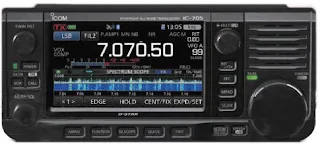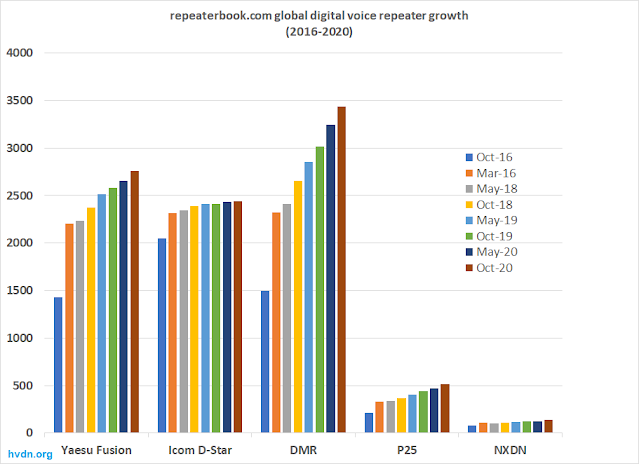Since 2016, there has been a tremendous increase of repeaters that support DMR, P25, NXDN, Fusion and D-Star digital voice amateur communication. Twice a year, HVDN tracks the total growth of digital voice repeaters in articles like this one.
Much has happened in the world since May 2020 and it does not seem like repeater growth trends have been drastically affected by the global COVID-19 pandemic after looking at the last four years of data. This shows that no matter what, digital growth will continue because radio amateurs love the hobby they are part of anywhere in the world.
All digital voice repeater information pulled for this update was done October 20th 2020 at 3:00 PM Eastern US time.
October 2020 Global Digital Voice Repeater Roundup
The data source used to compile this information is repeaterbook.com which is often very reliable and accurate.
Looking at the one year period from October 20th 2019 to October 20th 2020, we see that both DMR and P25 have the two highest growth percentages at 13.93% and 15.54% respectively.
Over the last four years from October 20th 2016 to October 20th 2020, DMR based amateur radio repeaters globally grew at a rate of 130.07% while P25 is at 140.85%.
This is not a fair comparison since volumes are drastically different, but it does show that there is huge interest in digital voice experimentation with either easy to get and affordable DMR equipment designed for the amateur enthusiast or via surplus only commercial P25 equipment that has come out of service from phase one deployments while commercial users either migrate towards phase two or systems that are LTE based cellular private networks or national programs such as the US based FirstNet.
Three Points: Why is DMR so popular globally?
There are three major reasons why DMR is the most popular global digital voice mode compared to Yaesu Fusion and Icom D-Star. NXDN and P25 are not compared further as they still are considered commercial only digital voice modes with no directly marketed amateur equipment.
Over the last year, Icom D-Star repeaters grew by 1.16% globally while Yaesu Fusion grew at 6.85%. Looking at the four years of data that HVDN has, Icom D-Star has a 19.01% growth but Fusion digital voice repeaters grew at 92.80%.
Even the commercial mode known as NXDN grew at 76.2% over the last four years and 10.4% in the last year alone. This is surprising given only surplus commercial equipment is available, such as what has been retired from certain railroads like the MTA MNRR in New York.
Based on global repeater growth data, DMR is the most popular digital voice mode as no one invests in deploying a repeater unless there are a number of local users who will actively spend time using it.
Point #1: Ecosystem
Icom has done a lot to modernize amateur radio and started the modern digital voice revolution back in 2002 via its D-Star digital voice products. Yaesu came to market in 2013 with its Fusion system which used FDMA (C4FM) based technology which has superior audio characteristics over the older GFSK based Icom D-Star.
Both vendors have a loyal following, but lack the ability to really to grow a multi-vendor ecosystem based on how the underlying digital voice technology they use could be licensed externally.
Kenwood came to market with the first over $500 digital voice based handheld radio that supports D-Star and could only do that by adding every other possible feature into a handheld radio to help offset the high D-Star licensing costs.
Many amateur radio operators like to have choices and DMR offers that since it is based on a commercial standard that is now open source with much lower per device licensing costs.
In 2016, there were 6 D-Star capable radios and 4 years later, there are only 7 with most of them falling in a premium price or greater category due to other non-DV features such as those found in the Icom IC-9700, IC-7100 and IC-705.
Yaesu has 6 Fusion capable radios, which is one less than in had in 2016 and also offers higher end equipment but has a broader portfolio that appeals to entry level and advanced fans of either Fusion, Yaesu or both.
 |
| The new Icom IC-52 D-Star radio will compete with lower cost or feature rich options such as the Kenwood TH-D74, Anytone D878 and Yaesu FT-3DR |
The 2020 crop of DMR equipment has at least 31 products spread across 11 vendors and a few even share compatible batteries and external microphones. Programming DMR radios via computer software is generally the same across vendors to make it easy when upgrading to another radio.
The Radioddity GD-77 and a few other DMR radios even support community driven alternative firmware to help make an even better non vendor specific ecosystem.
For any digital voice mode to succeed, as many vendors as possible need to have cross compatibility just like we have with the 30+ year old analog FM based equipment.
Point #2: Price
Because of how the D-Star technology is licensed, this contributes to higher costs of D-Star hardware and is why Icom is the only major supplier of D-Star equipment.
Even after its introduction in 2002, it has only seen Kenwood support D-Star through its very high end TH-D74 handheld radio which boasts a very wide feature set that appeals to radio enthusiasts not only looking for a dependable digital voice capable radio.
DMR has become popular in introducing digital voice to many radio amateurs because they are less expensive compared to the flag ship products offered by Yaesu with its FT-3DR handheld or the new but not yet released Icom IC-52.
While both radios are full touch screen and lack a full keypad, the DMR Anytone 878 handheld retails for more than 50% less than its Fusion or D-Star counterparts and is just as dependable in terms of quality, usability and construction.
 |
| Icom will sell many of the new IC-705 radios, but likely not just because it is D-Star capable |
Yaesu only started to see a large increase in repeater deployments after it released lower cost entry level equipment such as the FT-70 handheld or the FTM-7250 mobile radio. Icom still does not have a handheld or mobile radio close in price to a Fusion or DMR radio.
For Icom to succeed long term in digital voice, the IC-52 and any other products need to be priced closer to where DMR is succeeding.
Point #3: Resilience
DMR offers the only ability for a repeater owner to deploy a system that is not in any way dependent on the internet. Icom's D-Star requires users to have a registered ID and to be associated with a specific home repeater. The Yaesu Fusion system does not require a separate ID and relies just an an amateur radio callsign, but repeaters need to be internet connected to function.
When looking at DMR, a repeater owner can support two separate discussions at the same time on the same frequency without the internet. This becomes powerful when properly implemented especially when there is internet accessibility to share the repeater with other non local users.
An ID is required for DMR but the entire database of global users can be stored in your own radio.
When thinking about multiple networked repeaters, DMR offers much more flexibility to those looking to cover wide areas without true internet compared to Fusion or D-Star.
The next four years
Since 2016, HVDN has tracked digital voice technology to help educate radio amateurs globally, across the United States, in just New York and even just in the local area known as the Hudson Valley.
Based on our data, its clear that DMR is the current technology that is likely still going to be dominant over the next four years and possibly another twelve. While a new CODEC2 based open source digital voice mode is in development called M17, this is nothing that will impact the market until they have reliable equipment and supporting infrastructure.
In early October 2020, Steve K2GOG of HVDN gave a presentation about digital voice to the Orange County Amateur Radio Club (OCARC) in the Hudson Valley looking for guidance on what to invest in plus how to factor in hotspot impacts on how amateurs are using digital voice today.
No matter what, the next few years will be important as the amateur radio hobby continues to evolve and digital voice must be considered as part of that change in order to remain relevant for another 100 years.
Past Related Articles




https://m17project.org/
ReplyDelete